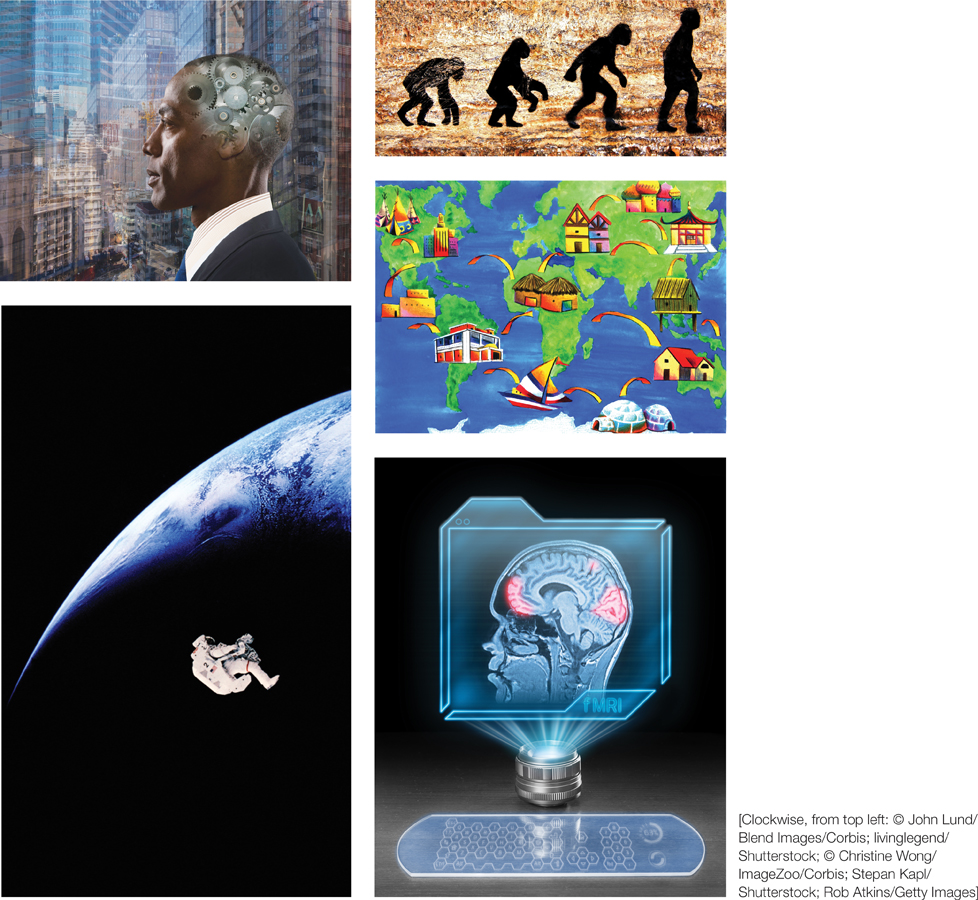1.1 The Roots of Social Psychology
Every human being has wondered, at one time or another, about him-
Although modern social psychology is sometimes characterized in textbooks and elsewhere as a field full of hundreds of small, largely disconnected theories about various aspects of social behavior, the field’s origins were influenced by several broad perspectives. Let’s briefly consider these influential ideas.
An Instinct-based View of Human Behavior

Webs created by spiders and humans: How much behavior is instinctual?
[Left: Maryna Pleshkun/Shutterstock; right: © Joe Baraban/Alamy]
In 1855, the British sociologist Herbert Spencer extended Charles Darwin’s theory of evolution by natural selection from the biological to the social realm. Spencer argued that social behavior is the result of the same evolutionary processes that produce physical characteristics such as body size and eye color. For example, Spencer felt that societies evolve just as organisms do, becoming larger, more complex, and more differentiated over time. Spencer’s evolutionary view of human activity heavily influenced William McDougall when he published the very first social psychology textbook, An Introduction to Social Psychology, in 1908. This textbook proposed that most human behavior was instinctively determined, just as it is for spiders that spin webs and beavers that build dams, and consequently unlearned and uninfluenced by experience. McDougall’s (1923) conception of instinctual human behavior stood in sharp contrast to what would become the two most dominant schools of thought in academic psychology during the first half of the 20th century: psychoanalysis and behaviorism.
3
Psychoanalytic Theory: The Hidden Desires That Guide Behavior
Inspired partly by Darwin’s concept of the “struggle for existence,” Sigmund Freud claimed that human behavior was directed primarily by aggressive and sexual drives (Freud, 1920/1961a). Aggressive behavior is critical for warding off predators and effectively competing for scarce resources; sexual behavior is critical for reproducing and perpetuating genes. But, because unbridled aggression and sexuality undermine the communal order necessary for very social human animals to survive, Freud proposed that human beings’ desires for sex and aggression are kept unconscious by repression, until they are transformed in ways that allow them to be consciously expressed in a socially acceptable fashion. This is the basis for Freud’s psychoanalytic theory that human behavior is directed by bodily desires excluded from consciousness to appease social forces. Consequently, a substantial proportion of human mental activity is unconscious, and what we are conscious of is rarely a direct reflection of the motivational underpinnings of what we’re doing, because the true intent of our behavior is generally hidden from us.
Behaviorism: Behavior Is Shaped by Experience
In direct opposition to psychoanalysis, early behaviorists such as John Watson (1930) argued that only overt behavior can be directly observed and measured and that phenomena such as feelings, wishes, unconscious processes, and consciousness are unob-
4
The Emergence of Modern Social Psychology
So what, then, causes human behavior? Is it instinct, as the McDougalls of the world argued? Is it the unconscious drives emphasized by Freud and his psychoanalyst disciples? Or is it experience via responses to the environment, as Watson avowed? And how do we sort out the role, if any, of unconscious and conscious mental processes in all of this? Social psychology emerged as a new field that would come to address these very questions. Its birth was sparked by two important and integrative books published in the 1920s.
In 1922, John Dewey published Human Nature and Conduct: An Introduction to Social Psychology, a seminal work that set the agenda for a mature social psychology. Dewey felt strongly that human behavior is determined by both instinct (nature) and experience (nurture) and that the key is to identify the complex interaction between nature and nurture. He also insisted that both unconscious and conscious processes are important determinants of human activity. Further, Dewey optimistically asserted that understanding the psychological underpinnings of human behavior would allow humans to influence what happens to us in the future by injecting informed reason into the mix of human instinct and environmentally determined experience. He thus saw humankind as a work in progress into which we can have at least some conscious input that may have monumental effects on human evolution. Dewey also stressed the uniquely existential concerns of human beings: How do self-
The other influential book of the 1920s was Floyd Allport’s Social Psychology, published in 1924. Allport tried to integrate into the study of consciousness the experimental techniques of behaviorism, the advances learned from psychoanalysis, and the ideas from evolutionary theory. Like Dewey, Allport was interested in how humans can apply what we learn about ourselves to promote constructive individual and social change. Social Psychology became the classic text in the field for decades and inspired a burst of empirical research that culminated in the 1931 publication of Experimental Social Psychology, by Gardner and Lois Murphy. Besides promoting the promise of experimental approaches to studying social psychological phenomena, this husband-
Another important development in social psychology stemmed from World War II and the desire to understand how individuals in a society could nearly annihilate a portion of their population. Events on the scale of the Holocaust demanded explanation, and social psychologists began testing theories of power and social influence, an interest that would also be fueled by the political activism that dominated the late 1960s. As research in social psychology grew in the 1950s and sixties, the field’s concern with understanding important social problems and unsavory forms of behavior contributed to a shift in focus from broad conceptions of human social behavior to relatively specific, topic-
During the 1970s and eighties, a cognitive revolution took hold in most of psychology. Social psychology was also swept up in this shift toward understanding the mental processes that underlie behavior. Most social psychologists began to embrace the metaphor of the human being as an information processor, a concept from which the social cognition perspective emerged. Social cognition is the way that an individual understands his or her own social world. The social cognition perspective focuses on how people perceive, remember, and interpret events and individuals in their social world, including themselves. This focus remains strong to the present day and has expanded to include newer techniques to measure the neural underpinnings of thought and emotion.
Social cognition
The way an individual understands his or her own social world.
Social cognition perspective
A view that focuses on how people perceive, remember, and interpret events and individuals, including themselves, in their social world.
5
Toward an Integrated Perspective on Human Behavior

There are five influential perspectives in social psychology: cognitive, evolutionary, cultural, neuroscience, and existential (depicted clockwise from top left).
[Clockwise, from top left: © John Lund/ Blend Images/Corbis; livinglegend/ Shutterstock; © Christine Wong/ ImageZoo/Corbis; Stepan Kapl/ Shutterstock; Rob Atkins/Getty Images]
Since the early 1990s, four trends that hark back to the roots of the field have combined forces with the social cognition perspective, leading to a renewed focus on answering the core questions from the field’s origins.
The first, the evolutionary perspective, is a reinvigorated effort to view humans as a species of animal and their social behavior as a consequence of particular evolutionary adaptations. The evolutionary perspective emphasizes that humans are animals and as such, subject to the same physical laws and evolutionary processes as all other forms of life. This suggests that a proper understanding of human activity requires recognizing uniquely human adaptations in addition to those we share with other creatures.
Evolutionary perspective
A view that humans are a species of animal and that their social behavior is a consequence of particular evolved adaptations.
6
The second, the cultural perspective, is a rediscovery of the importance of culture as a determinant of thinking and behavior. It emphasizes the central role of culture in just about everything people do. Social psychologists, perhaps not surprisingly given the “social” in social psychology, have always viewed humans as fundamentally social creatures biologically constructed to exist in proximity to, and to coordinate with, other members of their own species. Dogs, bees, ants, termites, and many other life forms are also social creatures, but humans stand apart. Unlike any other species, humans are cultural animals: Only humans create their own symbolic conception of reality. This creation is culture. Culture gives meaning to life, and it is taken to be an absolute representation of reality by those who share the same cultural background despite the fact that it is often clear, even to the casual observer, that people from different cultures can have radically different beliefs about the nature of reality.
Cultural perspective
A view that focuses on the influence of culture on thought, feeling, and behavior.
Cultural animals
Humans are animals who view reality through a set of symbols provided by the culture in which they are raised.
The third, the existential perspective, is a return to examining basic questions about existence and human nature, regarding matters such as meaning, identity, the body, and free will. Social psychologists are increasingly using an existential perspective to examine human behavior, devoting considerable attention to understanding the basic nature of the self and the core human motives; the needs for meaning and social connections; and the ways in which people cope with the often harsh realities of mortal life, the limits of the physical body, the possibilities of trauma and loss, and the inevitability of death.
Existential perspective
A view that focuses on the cognitive, affective, and behavioral consequences of basic aspects of the human condition such as the knowledge of mortality, the desire for meaning, and the precarious nature of identity.
The fourth, the social neuroscience perspective, is gaining increased momentum as technological advances enable us to understand better what is going on inside the brain when people engage in social thought and behavior. Social neuroscience utilizes assessments of brain-
Neuroscience perspective
The study of the neural processes that occur during social judgment and behavior. Neuroscience involves assessments of brain waves, brain imaging, and cardiovascular functioning.
|
Social psychology is a relatively young science, though humans have long been amateur social psychologists at heart. |
||
|---|---|---|
|
Roots In the mid- Freud claimed that human behavior is driven by aggressive and sexual drives that are largely hidden from our conscious experience. Behaviorists argued that only overt behavior can be directly observed and measured. They discounted the study of such things as feelings, wishes, and consciousness. The stage for modern social psychology was set by the integrative efforts of John Dewey, Floyd Allport, and Gardner and Lois Murphy. |
Perspectives of modern social psychology The social cognition perspective focuses on how we perceive, remember, and interpret events and people. The evolutionary perspective is a reinvigorated view of humans as a species of animal and of social behavior as a consequence of evolutionary adaptations. The cultural perspective underscores the effect of culture on thinking and behavior. The existential perspective focuses on basic human concerns such as mortality, meaning, and connection. The neuroscience perspective focuses on understanding how biological systems influence, and are influenced by, social processes. |
|
7
